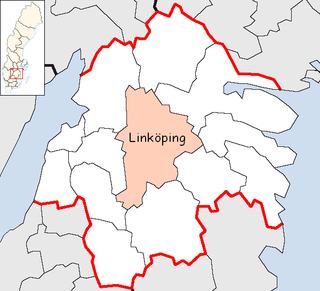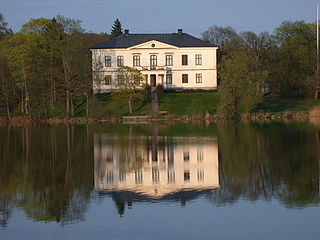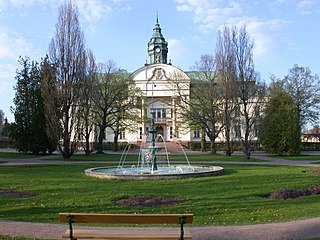
The Museum of Work, or Arbetets museum, as it is in Swedish, is a museum located in Norrköping, Sweden. The museum can be found in the 20th century building The Iron in the Motala ström river in central Norrköping.

The Göta Canal is a Swedish canal constructed in the early 19th century. It formed the backbone of a waterway stretching some 614 km (382 mi), linking a number of lakes and rivers to provide a route from Gothenburg (Göteborg) on the west coast to Söderköping on the Baltic Sea via the river Göta älv and the Trollhätte kanal, through the large lakes Vänern and Vättern.

Motala Municipality is a municipality in Östergötland County in southeast Sweden. Its seat is located in the city of Motala.

Östergötland County is a county or län in southeastern Sweden. It has land borders with the counties of Kalmar to the southeast, Jönköping to the southwest, Örebro to the northwest, and Södermanland to the northeast. It also has a sea border with Västra Götaland to the west, and borders the Baltic Sea to the east.

Vadstena Municipality is a municipality in Östergötland County in southeast Sweden. Its seat is located in the city of Vadstena.

Norrköping is a city in the province of Östergötland in eastern Sweden and the seat of Norrköping Municipality, Östergötland County, about 160 km southwest of the national capital Stockholm. The city has a population of 95,618 inhabitants in 2016, out of a municipal total of 130,050, making it Sweden's tenth largest city and eighth largest municipality.

The Motala longwave transmitter is a broadcasting station for longwave, established in 1927 in Motala, Sweden. Its aerial is of the T-type spun between two free standing steel framework towers, which still exist today. The transmitter was in service until 1962, when the new Orlunda longwave transmitter went in service. In 1991 the Swedish broadcasting company shut down its longwave transmitter. Nowadays the transmitter is an interesting technical museum, from which sometimes also transmissions with low power in the longwave range take place. These transmissions may not be received well from abroad.

Linköping Municipality is a municipality in Östergötland County in southern Sweden. With 152,966 inhabitants, it is the fifth largest municipality in Sweden.

AB Motala Verkstad is one of the oldest engineering companies in Sweden. The company was founded in 1822 during the construction of Göta Canal. Motala Verkstad has also built about 400 ships, 800 bridges, railway equipment, 1300 locomotives. The 118-meter-tall towers of Uppsala Cathedral were also built by Motala Verkstad. During the 1970s the company was the world's largest exporter of kitchen sinks and during the 1980s they built landing gear for Swedish-built aircraft. Today the company employs about 180 people.

Charlottenborg Herrgård is a manor house in Motala, on the shores of Motala Stream, Östergötland, Sweden. The house was built in the mid 17th century by Ludvig Wierich Lewenhaupt and named in honour of his wife, Charlotte von Hohenlohe-Neuenstein. Charlottenborg has been home to both Adam Ludwig Lewenhaupt and Daniel Fraser.

Övralid is a manor house north of Motala in Östergötland County, Sweden.

Medevi brunn is Scandinavia's oldest spa, located in Motala Municipality on the eastern shore of Lake Vättern, in north-west Östergötland, Sweden.

Ulvåsa, or Ulfåsa, is a mansion by lake Boren outside Motala in Östergötland, Sweden. The construction of the present mansion began in the 16th century. In the early 19th century a third floor was added and it obtained its present architecture.

Birgittas udde is situated on the south shore of lake Boren, Motala, Sweden. Medieval ruins of the Ulvåsa Manor House where St Birgitta lived most of her life. Next to the point, lies the modern Ulvåsa Castle.

Motala Motor Museum is a museum in Motala harbour, Sweden. The museum opened in 1995 and could be described as a "nostalgic museum". Over 200 vehicles; cars, mopeds, bicycles and 300 radios and TVs are displayed.

Daniel Fraser was a Scottish engineer who built a successful career in Sweden.
Motala Idrottspark is a football stadium in Motala, Sweden and the home stadium for the football team Motala AIF. Motala Idrottspark has a total capacity of 8,500 spectators.

Svartån is a river in eastern Sweden and the largest tributary to Motala ström. The river has a total length of 165 kilometers and a drainage basin area of 3410 km². Its source is situated close to Ormaryd in Jönköping County, about 10 kilometers east of the town of Nässjö, and the river initially flows north through Aneby, forming the Stalpet waterfall. From Aneby it continues through Gripenberg and the town of Tranås before entering lake Sommen. From Sommen it continues through Boxholm, Strålsnäs, Mjölby and Sya before entering the Östergötland plain. The mouth of the river is at lake Roxen, where it enters Motala ström.






















